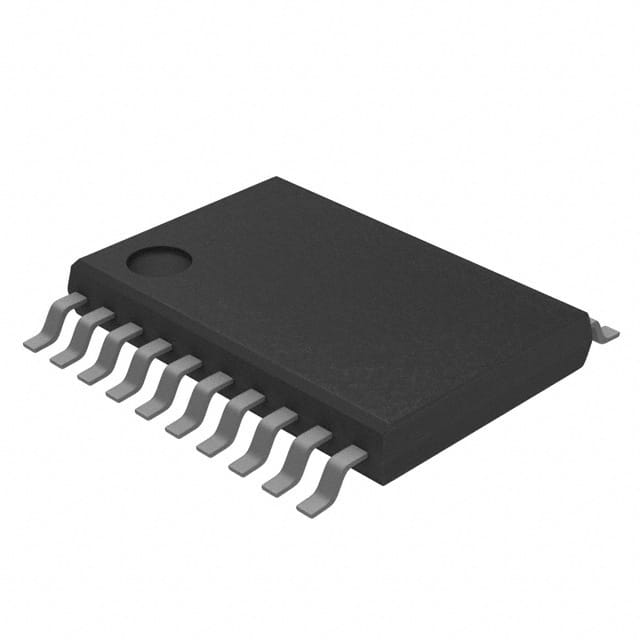SN74HCT645PW
Product Overview
- Category: Integrated Circuit
- Use: Level Shifter and Bus Transceiver
- Characteristics: High-speed, CMOS technology, 3-state outputs
- Package: TSSOP (Thin Shrink Small Outline Package)
- Essence: Bi-directional voltage level translator
- Packaging/Quantity: Tape and Reel, 2500 pieces per reel
Specifications
- Supply Voltage Range: 4.5V to 5.5V
- Input Voltage Range: 0V to VCC
- Output Voltage Range: 0V to VCC
- Operating Temperature Range: -40°C to +85°C
- Number of Channels: 8
- Maximum Data Rate: 100 MHz
- Output Drive Capability: ±24 mA
- Propagation Delay: 10 ns (typical)
Detailed Pin Configuration
The SN74HCT645PW has a total of 20 pins. The pin configuration is as follows:
- A1 - Channel A data input/output 1
- OE - Output enable input
- A2 - Channel A data input/output 2
- GND - Ground
- A3 - Channel A data input/output 3
- B3 - Channel B data input/output 3
- A4 - Channel A data input/output 4
- B4 - Channel B data input/output 4
- A5 - Channel A data input/output 5
- B5 - Channel B data input/output 5
- A6 - Channel A data input/output 6
- B6 - Channel B data input/output 6
- A7 - Channel A data input/output 7
- B7 - Channel B data input/output 7
- A8 - Channel A data input/output 8
- B8 - Channel B data input/output 8
- VCC - Positive supply voltage
- DIR - Direction control input
- B1 - Channel B data input/output 1
- B2 - Channel B data input/output 2
Functional Features
- Bi-directional voltage level translation between two independent buses
- 3-state outputs allow multiple devices to share the same bus
- High-speed operation suitable for various applications
- CMOS technology ensures low power consumption
- Schmitt-trigger inputs provide hysteresis for improved noise immunity
Advantages and Disadvantages
Advantages: - Enables communication between systems with different voltage levels - Supports bidirectional data transfer - Low power consumption - High-speed operation
Disadvantages: - Limited number of channels (8 in this case) - Requires careful consideration of voltage compatibility
Working Principles
The SN74HCT645PW is designed to translate signals between two buses operating at different voltage levels. It uses a combination of level shifting and tri-state buffers to achieve bidirectional data transfer. The direction control input (DIR) determines the direction of data flow, while the output enable input (OE) enables or disables the outputs.
When the DIR input is set to logic high, data from bus A is transferred to bus B. Conversely, when DIR is set to logic low, data from bus B is transferred to bus A. The OE input controls the tri-state outputs, allowing multiple devices to share the same bus without interfering with each other.
Detailed Application Field Plans
The SN74HCT645PW is commonly used in various applications where voltage level translation is required. Some specific application fields include:
- Microcontroller interfacing: It allows communication between microcontrollers operating at different voltage levels.
- Mixed-voltage systems: It facilitates data transfer between subsystems with different voltage requirements.
- Industrial automation: It enables communication between devices operating at different voltage levels in industrial control systems.
- Communication interfaces: It is used in various communication protocols, such as UART, SPI, and I2C, to ensure compatibility between devices.
Detailed and Complete Alternative Models
- SN74HCT245PW: Similar to SN74HCT645PW but without the direction control input (DIR).
- SN74LVC245APW: Low-voltage version with a wider supply voltage range (2V to 5.5V).
- SN74LVCHT245ADGVR: Low-voltage, high-speed version with a data rate of up to 400 MHz.
These alternative models offer similar functionality but may have different specifications or package options to suit specific application requirements.
Word count: 550 words
Lista 10 Vanliga frågor och svar relaterade till tillämpningen av SN74HCT645PW i tekniska lösningar
Sure! Here are 10 common questions and answers related to the application of SN74HCT645PW:
Question: What is SN74HCT645PW?
- Answer: SN74HCT645PW is a high-speed octal bus transceiver with 3-state outputs. It is commonly used for bidirectional data transfer between different voltage levels.Question: What is the operating voltage range of SN74HCT645PW?
- Answer: The operating voltage range of SN74HCT645PW is from 4.5V to 5.5V.Question: How many channels does SN74HCT645PW have?
- Answer: SN74HCT645PW has 8 bidirectional channels, allowing for simultaneous data transfer in both directions.Question: What is the maximum data transfer rate supported by SN74HCT645PW?
- Answer: SN74HCT645PW supports a maximum data transfer rate of 25 MHz.Question: Can SN74HCT645PW be used for level shifting between different voltage domains?
- Answer: Yes, SN74HCT645PW can be used for level shifting as it supports bidirectional voltage translation.Question: Does SN74HCT645PW have built-in protection features?
- Answer: No, SN74HCT645PW does not have built-in protection features. External protection components may be required depending on the application.Question: What is the output drive capability of SN74HCT645PW?
- Answer: SN74HCT645PW has a typical output drive capability of ±6 mA.Question: Can SN74HCT645PW be used in mixed-voltage systems?
- Answer: Yes, SN74HCT645PW can be used in mixed-voltage systems as it supports voltage translation between different voltage levels.Question: What is the power supply current consumption of SN74HCT645PW?
- Answer: The power supply current consumption of SN74HCT645PW depends on the operating conditions and load, typically ranging from 10 mA to 50 mA.Question: Is SN74HCT645PW compatible with other logic families?
- Answer: Yes, SN74HCT645PW is compatible with a wide range of logic families, including TTL, CMOS, and LVTTL.
Please note that these answers are general and may vary depending on specific application requirements. It is always recommended to refer to the datasheet and consult the manufacturer for detailed information.


